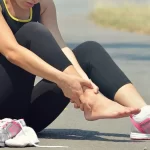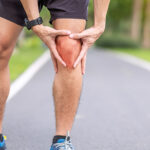Key Pointers:
- Learn what hip arthritis is and why it causes pain when walking
- Understand the common symptoms and causes of hip arthritis
- Find out how it’s diagnosed and what treatment options are available
- Discover when to seek help from an orthopaedic specialist in Singapore
What Is Hip Arthritis?
Hip arthritis refers to the gradual wearing away of the cartilage that cushions the ball-and-socket joint of the hip. This cartilage helps the joint move smoothly. When it breaks down, bones begin to rub against each other, leading to pain, stiffness, and reduced mobility.
The most common type is osteoarthritis, which develops with age or after injury. Other types include rheumatoid arthritis, caused by inflammation, and post-traumatic arthritis, which can follow hip fractures or injuries.
Why Does Hip Arthritis Cause Pain When Walking?
When the cartilage in your hip joint wears out, the joint surfaces lose their smoothness. Walking, climbing stairs, or standing for long periods put pressure on these roughened surfaces, triggering pain and inflammation.
Over time, the hip muscles may also weaken, and bone spurs (small bony projections) can form around the joint, adding to discomfort during movement.
What Are the Common Symptoms of Hip Arthritis?
Hip arthritis develops gradually, and symptoms can worsen over time. You may notice:
- Pain in the groin, buttock, or thigh when walking or standing
- Stiffness after sitting for long periods or waking up in the morning
- Reduced range of motion in the hip joint
- A “grinding” or “clicking” sensation when moving the leg
- Difficulty putting on shoes or bending forward
Pain may start mild and progress to affect daily activities such as walking, sitting, or getting in and out of a car.
How Is Hip Arthritis Diagnosed?
Your orthopaedic doctor will begin with a physical examination to assess your hip’s range of motion, strength, and stability.
Diagnostic tests may include:
- X-rays to check for joint space narrowing and bone changes
- MRI scans if cartilage damage or other joint conditions are suspected
A thorough assessment helps confirm the stage of arthritis and guides treatment planning.
What Are the Treatment Options for Hip Arthritis?
Depending on the severity and extent of joint damage, treatment may include non-surgical and surgical options.
1. Non-Surgical Management
- Lifestyle changes: Maintaining a healthy weight and avoiding high-impact activities can reduce stress on the hip.
- Medications: Anti-inflammatory medicines can help control pain and swelling.
- Physiotherapy: Targeted exercises improve strength and joint stability.
- Injections: Corticosteroid or hyaluronic acid injections may help reduce inflammation in some cases.
2. Surgical Options for Hip Arthritis
If conservative treatment is no longer effective, surgery may be recommended to repair or replace damaged tissue.
Meniscus Repair and Meniscectomy – What’s the Difference?
While these procedures are more commonly associated with knee arthritis or injury, similar principles apply to cartilage management around load-bearing joints like the hip.
- Meniscus Repair involves stitching the torn cartilage back together, allowing it to heal naturally. This approach preserves more of the original cartilage and is usually recommended when the tissue has good blood supply and healing potential.
- Meniscectomy, on the other hand, involves removing the damaged portion of the meniscus when repair isn’t possible. This relieves pain and prevents further tearing but may increase the long-term risk of arthritis due to reduced cushioning in the joint.
Post-surgery recovery:
- After meniscus repair, patients typically use crutches and limit weight-bearing for several weeks, followed by physiotherapy.
- After meniscectomy, recovery tends to be quicker, with many patients returning to daily activities within a few weeks.
Your orthopaedic surgeon will recommend the most suitable option based on your tear’s size, location, and your activity level.
Cartilage Resurfacing Surgery
In cases where the cartilage surface has worn down but the damage is localised, cartilage resurfacing may be considered. This minimally invasive procedure aims to restore the joint surface by:
- Removing the damaged cartilage
- Smoothing the underlying bone
- Applying biological or synthetic materials that encourage healing
Cartilage resurfacing helps delay the need for total joint replacement in some patients, preserving more of the natural joint structure.
Recovery involves physiotherapy to strengthen the surrounding muscles and restore motion. Most patients gradually resume normal activity within 6–12 weeks, depending on the extent of surgery.
When Should You See an Orthopaedic Specialist?
You should consider seeing a doctor if:
- Hip pain persists despite rest or over-the-counter medication
- You have stiffness that affects walking or daily activities
- You feel a grinding or locking sensation in your hip
- Pain wakes you at night or limits your sleep
- You experience sudden swelling or redness around the hip
Early diagnosis and management can help slow down joint deterioration and improve quality of life.
Frequently Asked Questions (FAQ)
- Can hip arthritis be cured?
There is currently no cure for arthritis, but symptoms can be managed effectively with treatment, exercise, and lifestyle adjustments. - Does hip arthritis always need surgery?
Not always. Many people find relief through physiotherapy, medication, and lifestyle changes. Surgery is considered when pain remains severe or mobility is significantly reduced. - What’s the difference between hip arthritis and hip bursitis?
Hip arthritis involves damage inside the joint, while bursitis affects the fluid-filled sacs (bursae) around the joint. Both can cause pain, but they differ in origin and treatment. - How do I know if my hip pain is arthritis or muscle-related?
Muscle pain usually improves with rest, while arthritis pain often worsens with activity and may be felt deep in the joint rather than the outer muscles. - Can exercise worsen hip arthritis?
High-impact activities can increase pain, but low-impact exercises like swimming, cycling, or gentle stretching can help maintain joint mobility and reduce stiffness.
When Hip Pain Becomes a Daily Struggle, Don’t Ignore It
If hip pain makes walking or everyday movement difficult, it’s time to get it checked. Dr Lee Eu Jin, Consultant Orthopaedic Surgeon at Liberty Orthopaedic Clinic, can assess your symptoms and recommend a personalised treatment plan.
From diagnosis to conservative management or surgical options, our clinic provides comprehensive care to help restore comfort and mobility.










